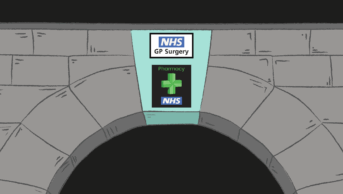
MAG / The Pharmaceutical Journal
On 20 December 2016, six days after the long-awaited report by the King’s Fund’s Richard Murray on the provision of clinical services in community pharmacy was published[1]
, health minister David Mowat described the review as “an essential road map that sets out how we are going to move the community pharmacy network away from a remuneration model”.
The report, which was commissioned by NHS England against a backdrop of looming financial cuts to community pharmacy services, was widely welcomed by pharmacy organisations, mainly because it had picked up on many of the proposals they had put forward in the ‘Community pharmacy forward view’ (CPFV) in August 2016[2]
.
There is a need to ensure that community pharmacy is integrated into the evolving new models of care
Sandra Gidley, chair of the Royal Pharmaceutical Society’s English Pharmacy Board, says the review “describes a clinical, patient-centred role for community pharmacists, completely in line with our own vision for the profession”.
Similarly, Rob Darracott, chief executive of Pharmacy Voice, a trade association that represents community pharmacy in England, says the review is an important piece of work. “It could and should shape up to £280m worth of government investment in exploring the pharmacy contribution to improving health,” he says.
With the NHS facing severe financial and operational challenges, the NHS needs “to make the most of the existing clinical services that community pharmacy can provide and to do so at pace”, Murray’s report says, which will require action through the national contractual framework, as well as at local level.

Source: Courtesy of the King’s Fund
Ensuring efficient NHS services helps ensure patient benefit, says Richard Murray, director of policy at the King’s Fund and author of the Murray review
“There is a need to ensure that community pharmacy is integrated into the evolving new models of care alongside other primary care professionals. This will include enhancing the support they provide to people with long-term conditions and public health, but should not be limited to these.”
Murray, director of policy at the King’s Fund, an independent health charity, says patient benefit is at the heart of the review, and was one of several criteria used to formulate the recommendations.
“Ensuring efficient NHS services helps ensure patient benefit,” he says, adding that where good evidence was not available, he has recommended further evaluation of services, for example through engaging with the existing NHS ‘Five year forward view’ vanguards. “We wanted to ensure that community pharmacy was part of this process and not separate from it.”
Integration of health services and collaboration between the medical and pharmacy professions is a strong theme of the review. Many of its recommendations are supported by evidence, but whether or not they will be implemented by NHS England is yet to be determined.
MURs: time to rebadge?
One of the review’s recommendations is to redesign medicines use reviews (MURs) “to include ongoing monitoring and regular follow-up with patients” with multiple comorbidities, as well as those with single conditions. “Ultimately, MURs should evolve into full clinical medication reviews utilising independent prescribing as part of the care pathway,” the report says.
MURs were introduced in 2005 and their format has not changed much since. Alastair Buxton, director of NHS services at the Pharmaceutical Services Negotiating Committee (PSNC), the negotiating body for community pharmacy contractors in England, says: “Things haven’t moved as radically as perhaps we would have envisaged back in 2005, so we welcome [the Murray review’s] recognition that there is some value [in MURs], but also that they need to change.”

Source: Pharmaceutical Services Negotiating Committee
Commissioners will determine whether pharmacists provide services for a patient with a single disease or whether they focus on patients with multi-morbidity, says Alastair Buxton, director of NHS services at the PSNC
Murray acknowledges that redesigning MURs in the way he suggests will be difficult. Full access to the patient’s health record would be required, and, ultimately, the ability to write to it and prescribe independently. “This is why we suggested an interim step of a review as part of a care plan, aiming over time to move to the fuller care package,” he says.
Darracott comments: “Those of us who were fearful that the [Murray] review would conclude that MURs — [which are] generally [not supported by robust, routinely collected] data on quality and utility — might be for the chop, will be relieved that instead it recommends a redesign, to ensure they link into a multifaceted approach to helping people with long-term conditions. That’s got to be right.”
The MUR is likely to have even less of a clinical impact because many GPs don’t value them
David Wright, professor of pharmacy practice at the University of East Anglia, was commissioned as part of the Murray review to examine the evidence base, value and operationalisation of clinical services provided by community pharmacy[3]
. He says that there isn’t a great deal of evidence that MURs generate benefits and are cost effective in their current form, but agrees that the lack of an evidence base does not necessarily mean that they are not having an impact or do not have the potential to have an impact.
However, when they were introduced, Wright says MURs were rushed in and beset with problems. There have also been reports of some large pharmacy chains pushing staff to conduct MURs that aren’t necessary[4],
[5]
. MURs need to be “rebadged”, so they are seen “in a positive light”, says Wright, meaning that they are focused on patients who need the service and provide ongoing monitoring and support.

Source: University of East Anglia / David Wright
David Wright, professor of pharmacy practice at the University of East Anglia, says the most efficient type of MUR intervention would be one where a pharmacist can make changes to a patient’s medication and share information with the rest of the healthcare team
Nevertheless, Wright does point out evidence that shows patient satisfaction with MURs[6]
and that patients know more about their medicines as a result of them. But in terms of the outcomes the NHS is interested in, such as reduced GP usage, fewer hospitalisations and improved clinical outcomes, the evidence isn’t there. That is because these kinds of studies are complex and take time. “The whole system in which we operate changes so rapidly,” he explains. “By the time they work out whether [a new intervention] works, the world in which it worked in is no longer the world that we are in now.”
One study evaluating the use of MURs in asthma patients showed that a nurse had already reviewed 70% of patients who undertook a MUR, suggesting that carrying them out was duplicating work[7]
. While repeating a message to a patient can be helpful, Wright explains, the researchers concluded that the patients who benefited most were the 30% who hadn’t been reviewed by a nurse.
If we… start changing everything and the GP rallies against it, it will do far more harm than good
In addition, a Cochrane review looking at interventions very similar to MURs concluded that one-off conversations with patients about their medicines are unlikely to have much clinical impact[8]
.
“The MUR is likely to have even less of a clinical impact because many GPs don’t value them and don’t follow them up,” Wright says. “If the GP is not on board then they are not going to do much with it, so it’s a wasted effort [on the pharmacist’s part].”
However, Wright points out that there have been a number of studies — including one involving patients with diabetes[9]
and several randomised controlled trials involving patients with hypertension[10]
— looking at the impact of MUR-like consultations where the patient has been followed up by the pharmacist, and by doing so, has achieved good clinical outcomes.
Wright suggests that the most efficient type of MUR intervention would be one where a pharmacist can make changes to a patient’s medication and share information with the rest of the healthcare team. This would require them to act as independent prescribers with the ability to not only access but also to write to a shared care record.
A lot of the problems with current pharmacy services is that they are “a bolt on” and carried out in ignorance of what else is happening to the patient, Wright says.
“It’s not wilful ignorance, it’s lack of access,” he explains, emphasising that access to the patient record and being able to contribute to it is “the cornerstone” for enabling clinical services to evolve in community pharmacy.
Pharmacists should also be able to make changes to medication, “but we need to be sure that the GP is happy with it”, Wright adds. This is because evidence shows that patients are more inclined to do things if they think it is authorised or supported by their GP, Wright explains.
“If we… start changing everything and the GP rallies against it, it will do far more harm than good, so we need to work together.”
Reducing GP workload
There is already a lot of evidence to show that, with clear guidance, pharmacists could manage and support patients with a single condition, such as hypertension.
“It’s a simple, easy win,” says Wright, who is involved with a trial in Great Yarmouth where GPs recommend certain asthma patients to pharmacists for their medication review. “We are not doing any duplication, we are only identifying those patients that the GP has recommended,” Wright explains. “Equally, patients will be more accepting of it because the GP has suggested it and also it should be relatively convenient for them because they are collecting medicine from [the pharmacy].”
Buxton says commissioners will determine whether pharmacists provide services for a patient with a single disease or whether they focus on patients with multi-morbidity who are identified as “the most needy”.
However, the focus on a single therapeutic area might support the move to independent prescribing through a “stepwise approach”, which is already being used in some parts of Canada, he says. Pharmacists in Ontario, for example, can only prescribe independently in a specific therapeutic area in which they have demonstrated competence[11]
, while in other provinces, GPs issue a prescription and a number of repeats, but the pharmacist can re-authorise the repeats for a specified period, as well as modify the dose to correct any errors or to step up or step down treatment.
“[Adopting a similar approach] would probably require legislative change in [England],” Buxton explains. “But we could have a phased approach to give more responsibility and the ability to modify and change, without having to put all the workload back to the GP prescriber, before we necessarily have [pharmacists] taking on full prescribing rights.”
Barriers to change
Wright acknowledges that the relationship between GPs and pharmacists is a major challenge that needs to be addressed if the role of community pharmacists is to be expanded, which is something that is reflected in the Murray review.
“GPs and pharmacists have got to see each other as partners, not as people fighting for the same business,” Wright explains, adding that one of his recommendations to the review — which he says wasn’t really picked up in the final document — focused on how to incentivise GPs and pharmacists to work better together. The Murray review notes that the knock-on effect of “poorly developed local relationships” is that it “continues to inhibit both integration and wider engagement” of pharmacists.
“NHS England and its national partners should consider how best to support [sustainability and transformation plans (STPs)] in integrating community pharmacy into plans,” the report says, adding that NHS England needs to look at how to “overcome the current complexities in the commissioning landscape”, and specifically “should look at the changes necessary to make Local Pharmaceutical Services (LPS) contracts easier to use”.

Source: Pharmacy Voice
NHS England needs to act quickly on the Murray review’s recommendations, says Rob Darracott, chief executive of Pharmacy Voice
“The ‘Five year forward view,’ and the latest incarnation of change — STPs — are, for now, ‘the only game in town’,” Darracott adds. “Some of the 44 STPs mention community pharmacy, but have little clue how to unlock the potential of the sector. The Murray review is a link into those wider transformation pieces; it’s a report to NHS England, and NHS England needs to act on it quickly.”
The PSNC, Pharmacy Voice and the RPS are currently working together to try to collect evidence of the problems some pharmacists face in “finding routes to the table” as well as problems engaging with commissioners in clinical commissioning groups (CCGs), STPs and vanguard sites.
But Buxton is not sure why LPS contracts are flagged as a problem. “We’ve not seen significant use of these historical LPS contracts,” he says. “They were meant to be used to contract innovative new services, [which] as a concept is fine, but they’ve never tended to be terribly innovative.
“If the CCG wants to commission a new innovative long-term condition management service, [it] can use the NHS standard contracts as [it] would with any other provider,” he adds.
Murray points out that NHS England can only commission services from community pharmacies either through the community pharmacy contractual framework or through LPS. “The view was that [LPS contracts] were not easy for NHS England teams to set up and monitor and are poorly understood by many contractors. Hence the recommendation is that LPS contracts should be made easier to use.”
Commissioning conundrum
The direction of travel is away from national commissioning and towards local commissioning. As a result, the government has committed to a locally commissioned minor ailments scheme, which the Murray review says NHS England must crack on with.
“NHS England should set out how it intends to deliver on this commitment and this should include testing models that use patient registration to enhance take-up, building on the experience in Scotland [where the service has been up and running since 2006],” it says.
The Murray review does recommend that one service is added to the national core contract — smoking cessation. Wright, who proposed its inclusion, says smoking cessation is one intervention that has massive benefits for the NHS. He says payment for the service could be attached to clinical outcomes, to focus the service on patients who have the most to gain from quitting, such as those with chronic obstructive pulmonary disease. “It would be nice if patients knew if they wanted to stop smoking, they could walk into a pharmacy anywhere and get that service,” he points out.
Buxton agrees but thinks it is “unlikely” that NHS England will pick up on the recommendation, despite the evidence base, because of the “current mantra” around commissioning and the fact that local authorities have cut funding for stop smoking services.
NHS England has yet to formally respond to the review, but Buxton says he is “working on the assumption that there is broad acceptance for a lot of it from NHS England because otherwise I wouldn’t have expected to have seen it published quite as quickly”.
However, he adds: “There is possibly a difference between acceptance in principle versus the reality of what can be funded or achieved.”
The government continues to make positive noises about the development of clinical services through community pharmacy, as laid out in the Murray review. During a debate on pharmacies and integrated healthcare on 11 January 2017, Mowat described the review as “an important piece of work… which will inform our policy”.
But the health minister is clear that the delivery of clinical pharmacy services in primary care needs a multipronged approach, and that pharmacists working in GP practices should not be seen as conflicting with what community pharmacists do, but as a way to facilitate better integration between the medical and pharmacy professions.
“It is not in conflict; it is a way of breaking down the barriers that I accept there have occasionally been between CCGs, GPs and the pharmacy profession,” the minister said. “[These barriers] are not in anyone’s interests, and we need to get over them.”
References
[1] Murray, R. Community pharmacy clinical services review. Available at: https://www.england.nhs.uk/commissioning/wp-content/uploads/sites/12/2016/12/community-pharm-clncl-serv-rev.pdf (accessed February 2017)
[2] Pharmacy Voice, Pharmaceutical Services Negotiating Committee, Royal Pharmaceutical Society. Community Pharmacy Forward View (2016). Available at: http://psnc.org.uk/wp-content/uploads/2016/08/CPFV-Aug-2016.pdf (accessed February 2017)
[3] Wright D. A rapid review of evidence regarding clinical services commissioned from community pharmacies. Available at: https://www.england.nhs.uk/commissioning/wp-content/uploads/sites/12/2016/12/rapid-evdnc-rev-dec-16.pdf (accessed February 2017)
[4] Chakrabortty A. How Boots went rogue. The Guardian 13 April 2016. Available at: http://www.theguardian.com/news/2016/apr/13/how-boots-went-rogue (accessed February 2017)
[5] Sukkar E. Have medicines use reviews come to represent profit over patient care? The Pharmaceutical Journal 2013;291:137. doi: 10.1211/PJ.2013.11124150
[6] Twigg MJ, Bhattacharya D, Clark A et al. What do patients need to know? A study to assess patients’ satisfaction with information about medicines. The International Journal of Pharmacy Practice 2016. doi: 10.1111/ijpp.12252
[7] Portlock J, Holden M, SPA community pharmacy asthma MUR project in Hampshire and the Isle of Wight. The Pharmaceutical Journal. 2009;282:109-12
[8] Ryan R, Santesso N, Lowe D et al. Interventions to improve safe and effective medicines use by consumers: an overview of systematic reviews. The Cochrane Database of Systematic Reviews 2014(4):Cd007768. doi: 10.1002/14651858.CD007768.pub3
[9] Ali M, Schifano F, Robinson P et al. Impact of community pharmacy diabetes monitoring and education programme on diabetes management: a randomized controlled study. Diabetic medicine: A Journal of the British Diabetic Association 2012;29(9):e326-33. doi: 10.1111/j.1464-5491.2012.03725.x
[10] Stewart K, George J, McNamara KP et al. A multifaceted pharmacist intervention to improve antihypertensive adherence: a cluster-randomized, controlled trial (HAPPy trial). Journal of Clinical Pharmacy and Therapeutics 2014;39(5):527-34. doi: 10.1111/jcpt.12185
[11] Ontario Ministry of Health and Long-Term Care. Healthcare Professionals: MedsCheck. Available at: http://www.health.gov.on.ca/en/pro/programs/drugs/medscheck/medscheck_original.aspx (accessed February 2017)


